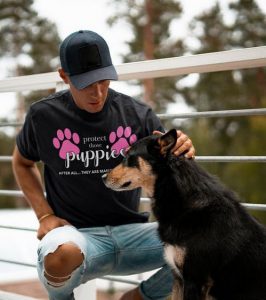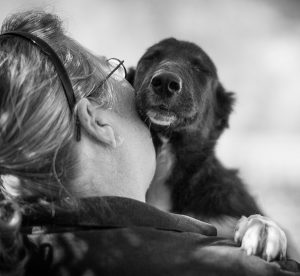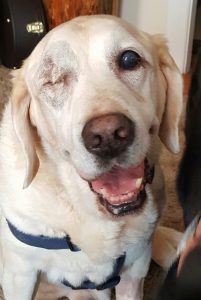
“The bond with a dog is as lasting as the ties of this earth can ever be.” – Konrad Lorenz
In This Issue: Animal Pain Awareness Month Highlights Importance of Pain Management; “Dog is Great. Dog is Good. Dog is Everything”; Upcoming PuppyUp Walks in September and October; Canine Melanoma Study Identifies Genetic Basis of Disease, Potential Drug Targets; 20-plus Clinics to Participate in Expanded Osteosarcoma Vaccine Clinical Trial; Why Losing a Pet Hurts So Much; Pup of the Month.
September is Animal Pain Awareness Month

In honor of Animal Pain Awareness Month in September, the Texas Veterinary Medical Association (TVMA) is educating pet owners on the many forms of pain and the importance of pain management options for all animal species.
From PR Web
AUSTIN, Texas (PRWEB) September, 2018
September is Animal Pain Awareness Month, a pet health event proclaimed by the International Veterinary Academy of Pain Management (IVAPM) that aims to encourage pain management for all animals through education and advocacy. The Texas Veterinary Medical Association (TVMA) is partnering with IVAPM by educating pet owners of the many forms of pain and the importance of pain management options for all animal species.
Unlike humans, pets cannot tell their human companions and doctors they are suffering from pain. They only can show signs and rely on their human counterparts’ ability to identify them. Some of those signs in dogs include excessive panting, limping, reluctance to lie down, sensitivity to touch, whimpering, howling and aggression. Common signs in cats are avoiding social interactions, loss of appetite, house soiling, hissing and aggression toward people and other housemates. The forms of pain vary from surgical and arthritis to cancer and injuries. In addition, pain presents itself in two ways: acute and chronic. Acute pain is distressing and obvious, marked with a change in a dog’s behavior, whereas chronic pain may be subtle and masked as “slowing down” or “aging.” Knowing the signs of pain and getting treatment for your pet is crucial because, left untreated, pain may lead to a host of problems, such as self-mutilation, compromised immunity and eventual deterioration.
TVMA member Christine New, DVM, who practices at Hillside Veterinary Clinic in Dallas, recommends scheduling a same-day appointment once pet owners suspect their pet is in pain. In the event the veterinary clinic is not open, it’s important to bring the pet to the local veterinary emergency clinic. Dr. New urges pet owners not to give their pets medication at home without instructions from a veterinarian.
“Almost all over-the-counter nonsteroidal anti-inflammatory drugs (NSAIDs), such as Aspirin, Ibuprofen and Naproxen, can be toxic to dogs and cats, causing severe gastrointestinal (GI) ulceration and even kidney or liver failure,” Dr. New said. “Even if your veterinarian has previously prescribed pain medication for your pet, it is still wise to check with a veterinary professional.”
Aside from veterinary-approved oral medicine, veterinarians may recommend injectable pain medicine, which often acts faster than oral tablets; physical rehabilitation; cold laser therapy; weight reduction and joint supplements, specifically if the pet is suffering from osteoarthritis; acupuncture; and massage therapy. The type of treatment depends on the source of pain. Veterinarians can identify the cause of the pain through diagnostic tools such as X-rays and bloodwork.
Partnering with your veterinarian is a vital component of pain management.
For the rest of the article, please follow this link.
Dog is Great. Dog is Good. Dog is Everything.
We love it when people with bright ideas, great products, and big hearts join with us in fighting cancer.
Have you heard of Dog Is Good (DIG)? Their motto is “A Dog Can Change the Way You See the World™,” and we all know that to be true.

We’re happy to say they’re helping the Puppy Up Foundation. For each purchase of one of these great “Protect Those Puppies” tees, DIG will donate a generous 20% of the price to the Foundation. Click here to place your order. And from September 19th through October 3rd, you can register to win one! Register here for your chance to win.
While you’re there, shop around and check out all the other great products they have: apparel, things for your car, items for the home, gifts for other dog lovers, pet products, and even cat stuff. And it’s not too early to think about those hard to shop for friends for the holidays. You’re certain to find something you’ll enjoy.
Thanks, DIG!
About Dog is Good
Located in Los Alamitos, CA, Dog is Good sells wholesale and retail, and licenses the brand to numerous manufacturers in the pet, gift and home decor industries. Their products are renowned for their clever and poignant sentiments, which appeal strongly to dog lovers worldwide. Primarily still known for their award-winning apparel line, the brand is quickly becoming widely recognized in the pet, gift and home decor markets for a wide variety of products. Dog is Good has developed a reputation for generously giving back to animal welfare organizations throughout the United States.
PuppyUp Walks in September and October

Upcoming PuppyUp Walks in September 2018
It’s a beautiful time of the year, as the leaves are just starting to turn in much of the country, and some of the hotter spots of the country are cooling down … or trying to. Coming up later this month, we have two PuppyUp Walks for you to enjoy with your favorite companions. And in October, we have SEVEN PuppyUp Walks! We hope there’s a Walk near you. If not, and you’d like to help organize one, please email us and let us know. Here’s where you can learn more.
September 23, 2018
PuppyUp Walk in New Paltz, NY
Adair Vineyards, New Paltz, NY
10:00 AM to 3:00 PM
September 23, 2018
PuppyUp Walk in Des Moines, IA
Raccoon River Park, West Des Moines, IA
12 Noon to 4:00 PM
7 PuppyUp Walks coming in October:
10/06/2018 PuppyUp Milwaukee, WI
10/07/2018 Puppy Up Shoreline, CT
10/14/2018 PuppyUp Monessen, PA
10/14/2018 PuppyUp Memphis, TN
10/20/2018 PuppyUp Long Island, NY
10/27/2018 PuppyUp Nashville, TN
10/28/2018 PuppyUp Fredericksburg, VA
For more information, to register or volunteer, please follow this link.
Canine Melanoma Study Identifies Genetic Basis of Disease, Potential Drug Targets

Canine melanoma study identifies genetic basis of disease, potential drug targets
by Steve Yozwiak, Translational Genomics Research Institute
As a veterinarian, Dr. Carolyn Duregger is familiar with the telltale signs of canine melanoma. So when she gave her own dog, Parker, a routine oral examination, the 1-centimeter-diameter discolored lump in the pup’s upper right gums took her breath away.
“It’s an aggressive cancer with poor prognosis that I’ve seen many times. My stomach dropped. I literally gasped,” said Dr. Duregger, recalling the moment she realized her fluffy, 9-year-old Wheaten terrier might be in big trouble.
Dr. Duregger surgically removed the cancerous lump, and started Parker on radiation and an immunotherapy drug. But these measures don’t always last, which is why she whole-heartedly supports the molecular-level precision medicine research led by the Translational Genomics Research Institute (TGen), an affiliate of City of Hope.
In the most comprehensive study of its kind, TGen and its collaborators from across the nation used multiple genomic analysis techniques to identify several gene mutations that could be the keys to what drives melanoma in dogs. Following the path from human melanoma, the findings of recurring molecular changes in canine melanoma can help veterinary physicians pinpoint potential new treatments for dogs. Likewise, human physicians will view these changes in light of the type of melanoma that occurs in non-sun exposed areas (as in the case of Parker) in the mouth, or other mucosal surfaces.
Researchers specifically identified mutations in a gene called PTPRJ, a tumor suppressor gene, according to the multi-year study published today in the journal PLOS Genetics.
“This mutational landscape of canine melanoma resembles that seen in human melanoma subtypes found in sun-shaded areas of the body, such as the nose and mouth, which remain difficult to treat. This similarity means that we have a genetic bridge across which understanding of the disease in either species can inform the other,” said Dr. Will Hendricks, a TGen Assistant Professor of Integrated Cancer Genomics, and the study’s lead author.
While melanoma is commonly associated with skin cancer, different types of melanoma can originate in different parts of the body, and it often spreads to the lungs, lymph nodes, bones and brain.
Researchers looked at 37 canine tumors and 17 control samples from a variety of dog breeds, and used several genomic analysis tools, including: whole genome sequencing, RNA sequencing, array comparative genomic hybridization, single nucleotide polymorphism array, and targeted Sanger sequencing analyses.
“Malignant melanoma is a significant cause of death among domestic dogs, and also provides a powerful comparative model for melanoma among humans,” said Dr. Jeffrey Trent, TGen President and Research Director, and the study’s senior author. “Overall, these data inform biological comparisons between canine and human melanoma, while suggesting actionable targets for both.”
The study found mutations in the PTPRJ tumor suppressor gene in seven of the tumors, and cancer-activating mutations in the RAS gene in nine of the tumors, in addition to changes in the genes MDM2 and TP53.
“Our genetic understanding of canine melanoma now allows us to continue to work to understand melanoma biology, and serves as a roadmap to developing and evaluating new treatment strategies,” Dr. Hendricks said.
The study examined several dog breeds with a propensity for melanoma, including Cocker Spaniels, an English Cocker Spaniel and a Labrador retriever. The paper—Somatic inactivating PTPRJ mutations and dysregulated pathways identified in canine malignant melanoma by integrated comparative genomic analysis—notes that an expanded study of breed-specific groups will be critical for further understanding of melanoma among dogs.
More information: William P. D. Hendricks et al. Somatic inactivating PTPRJ mutations and dysregulated pathways identified in canine malignant melanoma by integrated comparative genomic analysis, PLOS Genetics (2018). DOI: 10.1371/journal.pgen.1007589
Journal reference: PLoS Genetics
Provided by: Translational Genomics Research Institute
Published Sept 9 2018
20+ Clinics to Participate in Expanded Osteosarcoma Vaccine Clinical Trial
The immunotherapy treatment is designed to supplement amputation and chemotherapy
Initial results of a pilot study for canine osteosarcoma vaccine are promising, prompting a larger study to test its safety and efficacy.
Pharmaceutical company Aratana Therapeutics, which received conditional licensure for Live Listeria Vector (AT-014), has expanded its clinical trial to include more than two dozen veterinary oncology practice groups across the U.S. in order to receive full licensure. Conducted by the University of Pennsylvania School of Veterinary Medicine, the pilot study tested the immunotherapy treatment in 18 dogs. Those that received the vaccine lived more than twice as long as the historical, matched control group, with median survival times of 956 days compared to 423 days.
The expanded clinical trial is designed to collect additional safety data for the vaccine in dogs that have undergone amputation of the affected limb and have already completed chemotherapy.
If the treatment is found to be as safe and effective as it appeared in the initial clinical trial, Aratana will be given full licensure, allowing it to make the drug commercially available.
Live Listeria Vector (AT-014) is created by removing harmful genes from the Listeria bacteria and then attaching markers of osteosarcoma cells. It is designed to supplement standard osteosarcoma treatment of amputation and chemotherapy by attacking cancer cells that have spread to other organs.
The following clinics are participating in the expanded trial:
· Southern Arizona Veterinary Specialty and Emergency Center, Tucson, Ariz.
· Veterinary Cancer Group of Los Angeles, Culver City, Calif.
· SAGE Centers for Veterinary Specialty and Emergency Care, Campbell, Calif.
· Veterinary Specialty Hospital by ETHOS, San Diego, Calif.
· VRCC Veterinary Specialty & Emergency Hospital, Englewood, Colo.
· Veterinary Cancer Center, Norwalk, Conn.
· Southeast Veterinary Oncology and Internal Medicine, Jacksonville, Fla.
· Blue Pearl Specialty + Emergency Pet Hospital, Tampa, Fla.
· MedVet Medical & Cancer Centers for Pets, Carmel, Ind.
· Iowa State University, Ames, Iowa
· Blue Pearl Specialty + Emergency Pet Hospital, Overland Park, Kans.
· New England Veterinary Oncology Group, Waltham, Mass.
· Blue Pearl Specialty + Emergency Pet Hospital, Southfield, Mich.
· Oradell Animal Hospital, Paramus, N.J.
· VCA Veterinary Care Animal Hospital and Referral Center, Albuquerque, N.M
· Katonah Bedford Veterinary Center, Bedford Hills, N.Y.
· MedVet Medical & Cancer Centers for Pets – Columbus, Worthington, Ohio
· Veterinary Cancer & Surgery Specialists, Milwaukie, Ore.
· Hope Veterinary Specialists, Malvern, Penn.
· Upstate Veterinary Specialists, Greenville, S.C.
· Sugar Land Veterinary Specialists and Emergency Care, Sugar Land, Tex.
· Veterinary Specialist of North Texas, Ft. Worth, Tex.
· The LifeCentre, Springfield, Va.
· Bridge Animal Referral Center, Edmonds, Wash.
· Wisconsin Veterinary Referral Center, Waukesha, Wis.
Why Losing a Pet Hurts So Much … and why the stages of grief are just as valid when your loss is an animal.

Psychology Today
Ralph Ryback M.D.
“Until one has loved an animal, a part of one’s soul remains unawakened.” — Anatole France
A pet owner’s worst fear is losing a beloved companion. For those who have experienced this loss, there is usually a poignant story to share about a cherished dog or cat’s passing. From one pet owner to another, we understand the intense pain and emptiness that occurs after this loss. There is no correct way to grieve and work through this process, as everyone walks down a different journey with a pet.
A pet may symbolize a child, sibling, best friend or long-term companion. Dogs and cats live an average of 13 years—enough time to truly enter and live in your heart. They become a part of your family and daily life. Your morning routine may not be complete without playing fetch or going on a walk with your dog or snuggling with your feline.
The death of a pet can be a truly traumatic experience and create a large void in our hearts and lives—comparable to losing a close family member or friend. As humans, we project onto our beloved pets our thoughts, emotions, and ideas: We see ourselves in our animals. The common belief that “owners come to look like their pets” may not be a literal truism but rather a figure of speech indicating that our pets are our self-objects.
My own four-legged family members
I have had seven dogs, so I could be biased when I call them “running love.” Many people have known their dogs longer than their wives or children, so it is not surprising that their loss can be devastating even if it’s not sudden. I didn’t realize their stealthy Cupid effects until one of mine, a German Shepherd named Snitzel, went missing for three tearful days.
When a burly gravel truck driver made sexually provocative comments to my wife, Snitzel came running, without a word, snarling and taking up a protective position at her side, and that ended his comments and presence. And there are numerous examples of dogs rescuing humans, traits also observed in combat Marines and expressed in their mantra “Semper Fidelis” (always faithful or always loyal). Not surprisingly, a 1988 study in the Journal of Mental Health Counseling found that dog owners placed their dog as close as their closest family member and the closest of all in 38 percent of cases, Joe Yonan reported in The Washington Post.
To understand the kinship of dogs and humans, we might look at the qualities that humans think their friends should have. Laura Argintar in ADVICE suggests they include: no judgment, genuineness, trustworthiness, acceptance, respect, forgiveness, support, dependability, thoughtfulness, being a good listener, sharing humor, love. How does this stack up with the humans we know? Need I say more?
The magnitude of pet loss grief
A pet is truly a gift that can change your life and bring you monumental happiness and gratitude. Pets teach you responsibility, patience, kindness, discipline, playfulness and, most importantly, unconditional love. Even if your dog chews your couch, scratches your doors, and manages to eat every sock you own, you still figure out a way to share your home and heart with your companion.
The death of a pet can hurt as much as the loss of a close relative or friend. It is common for humans to have conflicts with family members over religion, money, politics and so forth—conflicts that may create emotional distance between them. Humans and pets do not have these types of conflicts—pets are 100 percent dependent on their human companion. Yes, you may become angry at your dog for chewing your shoelaces or leaving a “surprise” on your carpet, but these feelings of frustration and anger quickly dissipate after your pet looks up at you with funny ears and wide-open eyes.
According to an article that reviewed multiple studies and was published in the journal Society & Animals in 2002, the death of a companion animal can be as devastating as the loss of a human significant other.
For the rest of the article, please follow this link.
Pup of the Month — Barley Young

Barley Young
(by Amy Young)
Barley is a 12 year old yellow lab with more “joie de vive” in his one paw than any dog I’ve ever known. In June he was diagnosed with multiple melanomas in both of his beautiful brown eyes. He had surgery to remove his right eye, and is currently undergoing treatment to spare him the removal of his left eye. Whether he has one eye or no eyes he’s as beautiful as he’s ever been. Although the treatments have left him blind in his remaining eye, he’s been a champ throughout it all. He’s still adapting to his new world without sight and some days are better than others, but he inspires all who meet him just by being himself and is a daily reminder to all of us to ” live strong.”
Barley was a contestant in the 2017 Puppy Up Calendar Contest.
We can always use your help. If you’re interested, send me an mail at ginger@puppyup.org.
Sincerely,
Ginger Morgan, Executive Director
The Puppy Up Foundation








